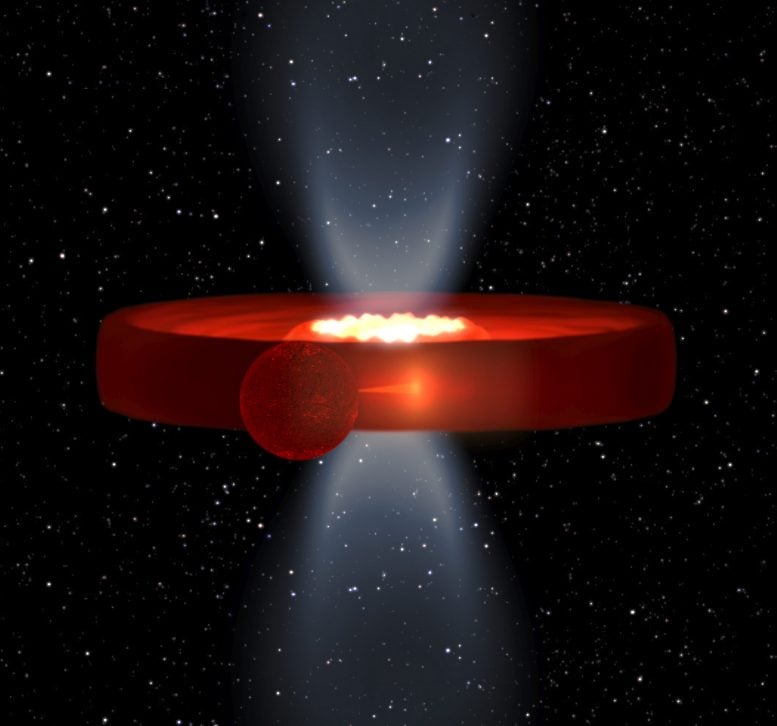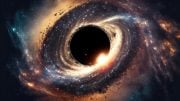
Edge-on view of the accretion disc, as seen from the Earth. A raised structure (like a donut), seen in the interior, causes the light from the inner parts of the disc (those closest to the black hole) to be eclipsed. This ‘donut’ gyrates around the black hole in a few minutes and produces eclipses over more or less regular intervals. Credit: Gabriel Pérez Díaz, Servicio MultiMedia (IAC)
In a newly published study, researchers report a black hole with a mass greater than three times that of the Sun in a 2.8-hour period around a low-mass donor star, seen at a very high inclination.
- Swift J1357.2-0933 is a black hole obscured by a disc of gas with a vertical structure (rather like a donut) that continues to expand
- This is the first time a black hole has been seen with this inclination and it’s the first time that eclipses in brightness have been detected in this kind of system
- The structure described in the study could be present in many other systems, which would make Swift J1357.2-0933 the prototype of a hitherto veiled population with a high inclination
Like an immense donut (or toroid) that expands daily. That’s how Jesús Corral-Santana, a researcher at the Instituto de Astrofísica de Canarias (IAC), describes the odd – hitherto unknown – structure of the binary system Swift J1357.2-0933, consisting of a ‘normal’ star and a stellar-mass black hole (which feeds off its companion star). The research, which Corral is the first author and is published in the latest issue of Science, follows the stages of the outburst of the system, an event that occurs only once in decades or centuries.
The team observed strange eclipses in the system that lasted and were repeated every few minutes. This finding led them to two conclusions: they had to be viewing the black hole edge on (it had an inclination of at least 75 degrees) and it presented an odd vertical structure within the accretion disc of the system. In other words, the matter being drawn from the companion star formed an outflow in the shape of a whirlpool, rather like water flowing down a plughole.
Simulation of the vertical obscuring structure in Swift J1357.2–0933. The torus hides the optical emission producing the dips. Its clumpy shape produces the described fast variability present within the dips. The torus outward expansion in the disk produces an increase in the DRP (Dip Recurrence Period).
As Jorge Casares, also an IAC researcher, coauthor of the paper, and Principal investigator (PI), explains, ‘this kind of structure is possibly present in many – or all – X-ray binaries, the class of systems to which Swift J1357.2-0933 belongs. So the object we’ve observed could be the prototype of a hitherto hidden population of highly inclined systems in which the black hole is obscured.’ Statistically, around 20% of systems could be of this type.
Black holes are formed following the death of very massive stars, and their detection is complicated. ‘Since they don’t emit any light, they’re nearly impossible to find if they are alone,’ says Casares. ‘In cases where they have a companion star, their probability of detection is much higher, since their presence is betrayed by the “cannibalization” of the companion star by the black hole.’ This explains why, since the first detection of such a system in 1964, only 18 other black holes have been found in our Galaxy. Swift J1357.2-0933, discovered by the Swift X-ray satellite and studied by the IAC team, is the latest one on the list. There are a further 32 black-hole candidates, but these haven’t yet been confirmed.
Many X-ray binaries are characterized by decades-long – even centuries-long – periods of quiescence, and it is easy to confuse them with normal stars when in this state. But, with no prior warning, these system can erupt, brightening dramatically (by as much as a million times their normal brilliance), in any part of the Galaxy. This enables them to be detected by satellites scanning the sky in X-rays. The system fades back to quiescence after a few months.
It’s then, adds Corral-Santana, that the scientific community can analyze its structure: a ‘normal’ star and a compact object (either a black hole, as in this case, or a neutron star). The star transfers material to its companion, forming an accretion disc.
In the case of Swift J1357.2-0933, the IAC researcher continues, more data have been gathered owing to its relative proximity, estimated at 5000 light-years, and its great distance above the plane of the Milky Way, where most of the matter of the Galaxy is concentrated, meaning that light from the binary system is not dimmed by interstellar dust or glare from nearby stars.
The scientists found that the system has a very short period, a mere 2.8 hours. In that time the companion star completes an orbit around the black hole. They also measured the mass of the black hole to be three times that of the Sun. ‘That’s a lower limit. In fact, the mass could be very much greater than that. Further observations during the period of quiescence would enable us to get a more accurate value,’ Corral-Santana explains.
However, the most unusual find concerns the eclipses of the system. From images taken with various telescopes at the Teide and Roque de los Muchachos Observatories (the IAC-80, Liverpool, Mercator, and INT), it was found that eclipses occurred in which the brightness of the system dropped by 30% in only seven seconds, and that they were repeated at longer intervals after a few days. ‘It’s the first time a phenomenon with these characteristics has been observed. None of the 50 known transitory X-ray binaries (18 with confirmed black holes and 32 candidates) produces eclipses by the companion star,’ the IAC astrophysicist points out.
What could be causing the eclipses? The researchers are clear that they aren’t produced by the companion star since these have orbital periods of 2.8 hours and the eclipses are produced every few minutes and are of extremely short duration. Corral-Santana further adds, ‘The period in which the eclipses are repeated gets progressively longer each day. This fact suggests that the eclipses are produced by a vertical structure that is initially located close to the black hole and gradually moves outwards like a wave from the inner part of the accretion disc.
This discovery is closely linked with another: ‘The simple fact of detecting the eclipses indicates that the system is viewed at a high inclination, even greater than 75 degrees. In effect, we’re looking at it edge on,’ says the scientist, who further describes the structure as, ‘probably like a donut, with the black hole permanently hidden in the middle.’
Reference: “A Black Hole Nova Obscured by an Inner Disk Torus” by J. M. Corral-Santana, J. Casares, T. Muñoz-Darias, P. Rodríguez-Gil, T. Shahbaz, M. A. P. Torres, C. Zurita and A. A. Tyndall, 1 March 2013, Science.
DOI: 10.1126/science.1228222









This is so strange; it makes me think of the globular objects seen almost umbilically attached to our sun just lately. would our sun be making little black holes?
There was discussion of the Tungusta event being a micro black hole that transited through the Earth.
Excellent presentation indeed. The brightness graph simulates PQRS graph of ECG. The dough-nut shape of the black hole as against spherical needs deep study however. Such a massive collapsing star is precluded to coelesce together by another super massive force like Dark Energy, which deflects light conically to spin. Thank You.
I happen to be commenting to let you know of the awesome discovery our girl
gained reading through your web page. She
came to find many things, which included what
it’s like to possess an ideal giving character to let other
individuals just thoroughly grasp various specialized subject areas.
You really exceeded our own expected results. Many thanks for providing these priceless,
trustworthy, informative and even easy thoughts on that topic to Julie.